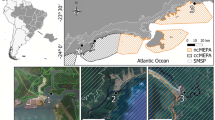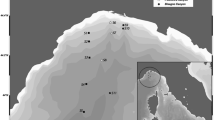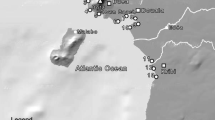Abstract
The eastern and southern coasts of the Gulf of Gemlik, a resort in the Sea of Marmara, Turkey, are under the influence of rapid ecotourism development, direct domestic and industrial discharges via rivers and outfalls, surface run-off, drainage from ports and shipping. According to sediment quality criteria in use around the world, sediment quality in the gulf shows a broad spectrum. It is more related by direct input, rather than by the type of sediment, and excluding inner port and southern coasts, it does not exert adverse biological effects yet. The total PAH concentrations range from 51 to 13,482 ng/g dry weight with the mean value of 1,850 ng/g dry weight (n = 61). The elevated values of the total toxic Benzo[a]pyrene equivalency (TEQcarc), with a maximum of 1,838 ng/g dry weight, were found at the inner harbor of Gemlik, possibly posing hazard to benthic organisms. Among the different PAHs, the contribution to the total TEQcarc decreased as the following order: Benzo[a]pyrene (43.6%) > Benzo[k]fluoranthene (36.0%) > Indeno[1,2,3-cd]pyrene (35.1%) > Benzo[b]fluoranthene (20.0%) > Chrysene + Triphenylene (18.9%) > Benzo[a]anthracene (12.5%).
Similar content being viewed by others
Explore related subjects
Discover the latest articles, news and stories from top researchers in related subjects.Avoid common mistakes on your manuscript.
In recent years, there has been great concern about the marine environment, especially relating to the presence of anthropogenic contaminants and their possible biological effects. As essential components of aquatic and marine ecosystems, sediments provide habitat for a wide variety of benthic organisms as well as juvenile forms of pelagic organisms. Benthic organisms are in constant contact with contaminants adsorbed to the sediment particles. The potential impacts include acute/chronic toxicity, bioaccumulation of contaminates, and passing of contaminants to predators of benthic species (Adams et al. 1992).
Monitoring of the contaminant concentrations is an important record to understand the natural biogeochemical processes of hydrocarbons in sediments. Such information is crucial to ecological risk assessment and management of marine areas with contaminant input. A similar study has been applied for the sediment of the Gulf of Gemlik (Ünlü and Alpar 2006) which show the concentration and possible sources of PAHs.
Sediment quality guideline values “effects range-low” (ERLs) and “effects range-median” (ERMs), representing possible-effects ranges of organics in sediment, are scientific tools that synthesize information regarding the relationships between the sediment concentrations of chemicals and any adverse biological effects resulting from exposure to these chemicals (Long et al. 1995). The objectives of this study were to assess the potential for sediment quality within the Gulf of Gemlik on the basis of internationally accepted values of National Oceanic and Atmospheric Administration (NOAA), and to identify those areas in which the potential for biological effects is greatest.
Materials and Methods
The methods used in this study have been described in detail (Ünlü and Alpar 2006) and will only be summarized here. The topmost 3 cm of the grab samples recovered from 61 stations in the Gulf of Gemlik were used. Extraction of frozen samples with a Soxhlet apparatus, cleanup procedure and analyses by gas chromatography coupled to mass spectrometry (GC/MS) were given in detail by Ünlü and Alpar (2006). The GC/MS was calibrated for the 14 priority pollutant PAHs using the internal standard calibration procedure described in US EPA method 8000 and also using the major characteristic ion of each compound for quantitation. The abbreviations used for the PAHs are: Phe: Phenanthrene, Ant: Anthracene, Flu: Fluoranthene, Py: Pyrene, BaA: Benzo[a]anthracene, Chry + Triph: Chrysene + Triphenylene, BbF: Benzo[b]fluoranthene, BkF: Benzo[k]fluoranthene, BeP: Benzo[e]pyrene, BaP: Benzo[a]pyrene, Per: Perylene, BPer: Benzo[ghi]perylene and IP: Indeno[1,2,3-cd]pyrene. Method detection limit for Phe, Ant, Flu, Py, BaA, Chry + Triph, were of the order of 1 ng/g dry sediment, while it was about 0.1 ng/g for other PAH compounds.
Results and Discussion
The Gulf of Gemlik is one of the most polluted hot spots in the Sea of Marmara, a semi-enclosed sea connecting the Black Sea to the Aegean Sea via Bosphorus and Dardanelles straits, Turkey (Fig. 1). It is a 31 km long, 6 km wide and 107 m deep tectonic trough, separated from the Sea of Marmara by a sill with an average depth of 50 m in the west. Having 27,600 km2 drainage area and 158 m3/s average water flows, the Karasu River is the most important geographic element in the region. It carries 0.5–5.5 tons of suspended solids daily into the sea (Yildiz et al. 2003). Industrial and domestic wastewater discharges of the Karsak creek into the Gemlik sea port in the east are 20 and 7.5 million m3/y, respectively (Akal Solmaz et al. 2000). Under the 20–30 m thick upper water body, the lower layer is less-energetic at the inner and central gulf, flowing at varying directions (Ünlü and Alpar 2006).
The Gulf of Gemlik is most particularly subject to high anthropogenic pressure due to riverine inputs, atmosphere, coastal shipping and industrial activities. The northern coasts are usually clean contrary to highly industrialized southern coasts. The easternmost part of the gulf is subject to chronic severe contaminations, among which hydrocarbons play a major role.
In marine and estuarine environments, PAHs tend to form associations with suspended and deposited particulate matter (Eisler 1987). It is known that this sorption of PAHs to sediments is strongly correlated with the total organic carbon (TOC) content and grain size of sediment. The surface sediments in the Gulf of Gemlik are mostly composed of silt and clay fractions (Ünlü and Alpar 2006). However, the PAH concentrations are weakly (30%) correlated with silt/clay ratios possibly due to the varying near-bottom suspension fluxes in the Gulf.
Exposure to PAHs may result in a wide range of effects on biological organisms. While some PAHs are known to be carcinogenic, others display little or no carcinogenic, mutagenic or teratogenic activity (Neff 1979; Sims and Overcash 1983). Several PAHs exhibit low levels of toxicity to terrestrial life forms, yet are highly toxic to aquatic organisms (Eisler 1987). The bioavailability and toxicity of PAHs may depend on the concentration of TOC in the sediment (Bolton et al. 1985; Lyman et al. 1987). The organic carbon contents in the sediments (0.07–3.05% with an average of 1.43) are generally higher in deep trough and at Gemlik and Trilye harbours (Ünlü et al. 2006). We suggest that the productive and varied benthic microfauna in the Gulf of Gemlik contribute to the organic carbon level in the benthic sediment masking any relationship which may exist between total PAHs and organic carbon. Foraminiferal density and species richness of the assemblages in the sediments decrease with an increase in heavy metal and PAH concentration. The highly polluted areas given by Ünlü and Alpar (2006) are dominated by the tolerant pioneer species Amonia tepida and possibly Ammonia compacta and Elphidium crispum that may be used as bio-indicators of pollution, mainly in the inner part of harbor (Meriç et al. 2005; Ünlü et al. 2008). Some anomalous individuals have also been observed by Meriç et al. (2005) in the highly polluted sediment samples from the southern coast (e.g. G06, 07, 17, 25, 26 and 34).
The total PAH concentrations (sum of the 14 EPA priority pollutants) in sediments of the Gulf of Gemlik ranged from 51 to 13,482 ng/g dry weight with the mean value of 1,850 ng/g dry weight (n = 61). Maximum PAH levels were found in some specific local areas; in front of Gemlik harbour (sites G1, G2, G79 and G80) and ports (G4), nearshore the cable and petroleum plants at Güzelyali, 3 km east of Mudanya (stations G26 and G27), in front of a creek at Kursunlu (G17) and finally in Mudanya (G28) and Trilye (G33) villages. These sites are all at the easternmost and southern parts of the gulf (Ünlü and Alpar 2006).
The effects range low and median (ERL and ERM) values were used for assessment of aquatic sediment with a ranking of low to high impact values (Long et al. 1995). The measured concentrations of PAHs were compared with the ERL and ERM values (Table 1).
Results showed that the average total PAH concentrations were below the ERL and ERM. For individual components this result is also valid, except the case of Phe. On the other hand, the worst cases of Phe, Ant and BaP compounds for some sites exceeded ERM. These findings indicate that some sites should have potential biological impact on benthic organisms. These sites coincide with the nearshore areas with high anthropogenic input coming from the marinas, ports, three local fuel storage terminals (Gemlik town, Kursunlu-Tuzla Point, Mudanya and Trilye sea port) and anchoring areas scattered in and around the Gemlik harbour. In sediments collected from the central, western exit and northern sectors of the gulf, the sediment quality is much better that those observed in the eastern and southern coasts. Bottom currents of the dense lower layer flowing alongside the southern and eastern coasts of the gulf seem to not have much effect on sediment quality.
Some PAHs are of great concern due to their documented carcinogenicity (Eisler 1987; Long et al. 1995; Neff 2002). Total concentrations of potentially carcinogenic PAHs (CPAH), including BaA, benzofluoranthenes, BaP and IP, varied from nil to 1,794 ng/g dry weight with the average of 87 ng/g dry weight. They accounted for 65–100% of total PAHs in sediments from the Gulf of Gemlik, if we exclude the sampling stations of G7, G24, G29, G32, G34, G35, G55, G59, G68, G69 and G70 which are distributed far from the industrialized coastal settlements.
Among all known potentially carcinogenic PAHs, BaP is the only PAH for which toxicological data are sufficient for derivation of a carcinogenic potency factor (Peters et al. 1999). The toxic equivalency factors (TEFscarc) were used to quantify the carcinogenicity of other PAHs relative to BaP (Nadal et al. 2004).
Calculated TEFs for BaA, BaP, BbF, BkF, IP and Chry are 0.1, 1, 0.1, 0.01, 0.1, and 0.001, respectively, according to the USEPA. In this study, we converted the above mentioned six PAH concentrations into one toxic concentration for each site using the corresponding TEFcarc. The total toxic BaP equivalent (TEQcarc) for all PAHs was calculated as (Qiao et al. 2006):
Excluding 17 unpolluted samples mostly located in the central and western parts of the gulf, the total TEQcarc values calculated for samples varied from 5.6 to 1,838 ng/g dry weight TEQcarc, with an average of 134 ng/g dry weight TEQcarc. The maximum total TEQcarc values were found at the inner harbor of Gemlik; sites G1 and G79. Among different PAHs, contribution to the total TEQcarc decreased in the order: BaP (43.6%) > BkF (36.0%) > IP (35.1%) > BbF (20.0%) > Chry + Triph (18.9%) > BaA (12.5%).
In conclusion, the present work represents the first study on the estimation of the sediment quality in the Gulf of Gemlik which hosts both urbanized industrial areas and resort areas. The poor sediment quality is found at the localities of Gemlik, Mudanya and Trilye, which originates mainly from municipal effluents, local fuel storage terminals, spillage from vessels, urban vehicle traffic, other port operations and atmospheric deposition/transport.
Results of the concentrations of PAH compounds of bottom sediments were compared to international accepted values. Data showed that the average concentration of compounds was usually less than that of Interim Sediment Quality Guideline (ISQG) and ERL and ERM values, except nearshore areas along the Tuzla point, Kursunlu and Mudanya where some of the anomalous individuals have been also observed (stations G06, 07, 17, 25 and 26). Comparisons to the NOAA’s ERM values indicate that the elevated concentrations of PAHs at several locations in the Gulf of Gemlik may pose serious hazard to benthic organisms, probably causing the anomalous effects reported previously by Meriç et al. (2005). It is recommended that bioaccumulation tests are to be performed to determine the biological significance of sediment associated contaminants especially at the inner harbour and along the southern coasts of the Gulf of Gemlik.
References
Adams WJ, Kimerle RA, Barnett JW Jr (1992) Sediment quality and aquatic life assessment. Environ Sci Technol 26(10):1864–1875. doi:10.1021/es00034a001
Akal Solmaz SK, Yonar T, Üstün GE (2000) Gemlik Körfezinin karasal kaynaklı kirlilik envanteri. In: Öztürk B, Kadıoğlu M, Öztürk H (eds), Marmara Denizi 2000 Sempozyumu, TÜDAV, 11–12 November 2000, Istanbul (in Turkish), 5:513–519
Bolton HS, Breteler RJ, Vigon BW, Scanlon JA, Clark SL (1985) National perspective on sediment quality. Prepared by Battelle Institute, Washington, DC for US EPA Contract No. 68-01-6986. US Environmental Protection Agency, Washington DC
Eisler R (1987) Polycyclic Aromatic Hydrocarbons Hazards to Fish, Wildlife, and Invertebrates: A Synoptic Review. US Fish and Wildlife Service, Biological Report No 85(1.11), Washington DC
Long ER, Macdonald DD, Smith SL, Calder FD (1995) Incidence of adverse biological effects within ranges of chemical concentrations in marine and estuary sediments. Environ Manage 19(1):81–97. doi:10.1007/BF02472006
Lyman WJ, Glazer AE, Ong JH, Coons SF (1987) An overview of sediment quality in the United States. Final Report. Contract No. 68-01-6951, Task 20. PB88-251384. US EPA, Washington, DC p 204
Meriç E, Avşar N, Nazik A, Alpar B, Yökeş B, Barut İF, Ünlü S (2005) Gemlik Körfezi yüzey çökellerinin foraminifer, ostrakod ve mollusk faunası, foraminifer kavkılarında gözlenen morfolojik anomaliler ile bölgenin sedimentolojik, hidrokimyasal ve biokimyasal özellikleri. MTA Dergisi 131:21–48 (in Turkish)
Nadal M, Schuhmacher M, Domingo JL (2004) Levels of PAHs in soil and vegetation samples from Tarragona County, Spain. Environ Pollut 132:1–11. doi:10.1016/j.envpol.2004.04.003
Neff JM (1979) Polycyclic aromatic hydrocarbons in the aquatic environment. Sources, fates and biological effects. Applied Science Publishers, England
Neff JM (2002) Bioaccumulation in marine organisms: effect of contaminants from oil well produced water. Elsevier, Amsterdam 452
Peters CA, Knightes CD, Brown DG (1999) Long-term composition dynamics of PAH-containing NAPLs and implications for risk assessment. Environ Sci Technol 33(24):4499–4507. doi:10.1021/es981203e
Qiao M, Wang C, Huang S, Wang D, Wang Z (2006) Composition, sources, and potential toxicological significance of PAHs in the surface sediments of the Meiliang Bay, Taihu Lake, China. Environ Int 32:28–33. doi:10.1016/j.envint.2005.04.005
Sims RC, Overcash MR (1983) Fate of polynuclear aromatic compounds (PNAs) in soil-plant systems. Residue Rev 88:1–68
Ünlü S, Alpar B (2006) Distribution and sources of hydrocarbons in surface sediments of Gemlik Bay (Marmara Sea, Turkey). Chem 64:764–777
Ünlü S, Alpar B, Aydin S, Akbulak C, Balkis N, Barut I, Meriç E, Aksu A, Kirbasoglu Ç (2006) Anthropogenic pollution in sediments from the Gulf of Gemlik (Marmara Sea, Turkey); cause-result relationship. Fresenius Environ Bull 15(12a):1521–1560
Ünlü S, Topçuoğlu S, Alpar B, Kirbasoğlu C, Yilmaz YZ (2008) Heavy metal pollution in surface sediment and mussel samples in the Gulf of Gemlik. Environ Monit Assess 144(1–3):169–178. doi:10.1007/s10661-007-9986-6
Yildiz M, Uçar I, Özay E, Balgat I (2003) Monthly water regimes for the period of 1935–2000. Publications of General Directorate of Electrical Power Resources Survey and Development Administration (EIE), No: 95-25, ISBN 975-7566, Ankara, Turkey (in Turkish)
Acknowledgments
The present work has been supported by the Research Fund of Istanbul University; the projects UDP-2624, YFK-186 and BYP-1894.
Author information
Authors and Affiliations
Corresponding author
Rights and permissions
About this article
Cite this article
Ünlü, S., Alpar, B. Evolution of Potential Ecological Impacts of the Bottom Sediment from the Gulf of Gemlik; Marmara Sea, Turkey. Bull Environ Contam Toxicol 83, 903–906 (2009). https://doi.org/10.1007/s00128-009-9803-8
Received:
Accepted:
Published:
Issue Date:
DOI: https://doi.org/10.1007/s00128-009-9803-8





